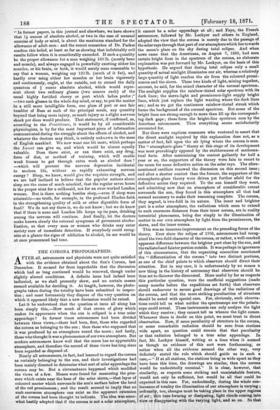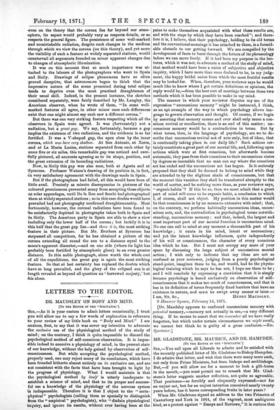THE CORONA PHOTOGRAPHED.
AFTER all, astronomers and physicists were not quite satisfied with the evidence obtained about the Sun's Corona, last December. It seemed far from improbable that the discussion which had so long continued would be renewed, though under slightly altered conditions. A definite issue had indeed been indicated, as we shall presently show, and no certain means seemed available for deciding it. At length, however, the photo- graphs taken during the totality have been submitted to inspec- tion ; and most fortunately they dispose of the very question on which it appeared likely that a new discussion would be raised.
Let it be understood that the question at issue all along has been simply this,—How much of that crown of glory which makes its appearance when the sun is eclipsed is a true solar appendage ? In former times astronomers had been divided between three views,—there had been, first, those who regarded the corona as belonging to the sun ; then those who supposed that it was produced by an atmosphere round the moon ; and lastly, those who thought it was a phenomenon of our own atmosphere. But modern astronomers know well that the moon has no appreciable atmosphere, and therefore the second of these views has long since been regarded as disposed of.
Nearly all astronomers, in fact, had learned to regard the corona as certainly belonging to the sun, and their investigations had been mainly directed to determine what sort of solar appendage the corona may be. But a circumstance happened which modified the views of a few. Means were found for measuring the pres- sure which exists near the base of the solar sierra,—that layer of coloured matter which surrounds the sun's surface below the level of the red prominences ; and the result seemed to imply that no such enormous atmosphere can exist as the apparent extension of the corona had been thought to indicate. The idea was some- what hastily adopted that if the corona is not a solar atmosphere, it cannot be a solar appendage at all ; and Faye, the French astronomer, followed by Mr. Lockyer and others in England, adopted the view that the corona is merely due to the passage of the solar rays through that part of our atmosphere which lies towards the moon's place on the sky during total eclipse. And when news came that the Americans, on August 7, 1869, had seen certain bright lines in the spectrum of the corona, an elaborate explanation was put forward by Mr. Lockyer, on the basis of this hypothesis. He argued that during total eclipse only a small quantity of actual sunlight illuminates our air, whereas a relatively large quantity of light reaches the air from the coloured promi- nences and the sierra. These two kinds of light, mixing together, account, he said, for the mixed character of the coronal spectrum. The sunlight supplies the rainbow-tinted solar spectrum with its dark lines ; the sierra-light and prominence-light supply bright lines, which just replace the light wanting where the dark lines are ; and so we get the continuous rainbow-tinted streak which forms the background of the coronal spectrum. But some of the bright lines are strong enough to more than fill up the correspond- ing dark gaps ; these form the bright-line spectrum seen by the American astronomers. Thus everything seems satisfactorily accounted for.
But there were captious reasoners who ventured to assert that the direct sunlight required by this explanation does not, as a matter of fact, fall upon the air lying where the corona is seen. The " atmospheric-glare " theory at this stage of its development was most provokingly opposed by the stubbornness of mathema- tical facts. After maintaining the contest gallantly for half a year or so, the supporters of the theory were fain to resort to the moon for some deflective action on the solar rays. The afore- mentioned cavillers renewed the discussion on this second issue ; and after a shorter contest than the former, the supporters of the atmospheric-glare theory were driven yet further afield for the deflective action they required. To the sun himself they went, and admitting now that an atmosphere of considerable extent surrounds the sun, they found in this atmosphere all that had seemed necessary to make their reasoning complete. The corona, they argued, is two-fold in its nature. The inner and brighter part is a solar atmosphere, the radiations which seem to extend to such enormous distances from their inner corona, are in reality terrestrial phenomena, being due simply to the illumination of matter in our own atmosphere by light from the prominences, the sierra, and the inner corona.
This was an immense improvement on the preceding forms of the theory. Ever since the eclipse of 1706, astronomers had recog- nized the two-fold character of the corona, or rather, a well-marked apparent difference between the brighter part close by the sun, and the radiated and fainter portion outside. It was perhaps in ignorance of this circumstance, that the organizing committee mentioned the " differentiation of the corona" into two distinct portions, as one of the chief points to which observers should direct their attention. But in any case, it is unfortunately by no means a new thing in the history of astronomy that observers should be thus set to discover the discovered. More useful by far as respects this particular question, were the unofficial suggestions (made many months before the expeditions set forth) that observers should endeavour to secure good drawings of the radiations of the corona, and that the more striking peculiarities of structure should be noted with special care. For, obviously, such observa- tions could tell us what neither the spectroscope nor the polaris- cope could reveal. These instruments can only analyze the light which they receive ; they cannot tell us whence the light comes. Whenever there is doubt on this point, we must trust to direct observation. Now, if some peculiarity of structure in the corona, or some remarkable radiation should be seen from stations wide apart, no question could remain that that peculiarity or that radiation belonged to a true solar appendage. In fact, Mr. Lockyer himself, writing at a time when it seemed as though no evidence of this sort were forthcoming, or rather when all the evidence seemed the other way, very definitely stated the rule which should guide us in such a case,—" If at all stations, the stations being as wide apart as they have been this time, the drawings are similar, then the corona would be undoubtedly cosmical." It is clear, however, that similarity, as respects some striking and unmistakable feature, would not only be sufficient, but would be all that could be expected in this case. For, undoubtedly, during the whole con- tinuance of totality the illumination of our atmosphere is varying ; ordinarily, too, changes must be taking place in the upper regions of air ; thin haze forming or dissipating, light clouds coming into view or disappearing with the varying light, and so on. So that
-even on the theory that the corona lies far beyond our atmo- -sphere, its aspect would probably vary as respects details, or as respects the general figure. The persistence of some well-marked and unmistakable radiation, despite such changes in the medium through which we view the corona (on this theory), and yet more the visibility of such a feature at widely separated stations, would .00untervail all arguments founded on minor apparent changes due to changes of atmospheric illumination.
It was on this account that so much importance was at- tached to the labours of the photographers who went to Spain and Sicily. Drawings of eclipse phenomena have so often proved deceptive, that astronomers began to think that the impressive nature of the scene presented during total eclipse tends to deprive even the most practised draughtsmen of 'their usual skill. Indeed, in the present instance, the sketches -considered separately, were fairly described by Mr. Langley, the American observer, when he wrote of them, "In some well- marked features all agree, in other minor ones such differences -.exist that one might almost say each saw a different corona."
But there was one very striking feature respecting which all the .observers in Spain were agreed. It was (fortunately) not a radiation, but a great gap. We say, fortunately, because a gap implies the existence of two radiations, and the evidence is so far fortified. It was a V-shaped gap, the apex close by the inner -corona, which was here very shallow. At San Antonio, at Xeres, and at La Maria Louisa, stations separated from each other by some five or six miles, this remarkable gap was noticed and care- 'fully pictured, all accounts agreeing as to its shape, position, and the great extension of its bounding radiations.
Now, in Sicily this gap was also seen, both at Agosta and at Syracuse. Professor Watson's drawing of its position is, in fact, fin very satisfactory agreement with the drawings made in Spain.
But if the photographers had failed, all this would have been of little avail. Precisely as minute discrepancies in pictures of the coloured prominences prevented many from accepting those objects as solar appendages, until De la Rue and Secchi had photographed them at widely separated stations ; so in this case doubts would have prevailed had not photography confirmed draughtsmanship. Most fortunately, however, the coronal radiations have been found to be satisfactorily depicted in photographs taken both in Spain and in Sicily. The American party in Spain are able to show a view including only the lower half of the corona ; but luckily it is in this half that the great gap lies—and there it is, the most striking feature in their picture. But Mr. Brothers at Syracuse has surpassed all competitors, for he has obtained a picture of the corona extending all round the sun to a distance equal to the moon's apparent diameter,—and on one side (where its light has probably been fortified by atmospheric glare) to an even greater distance. In this noble photograph, alone worth the whole cost .of all the expeditions, the great gap is again the most striking 'feature. So that at last certainty has replaced the doubts which /have so long prevailed, and the glory of the eclipsed sun is at length revealed as beyond all question no ' borrowed majesty,' but this alone.



































 Previous page
Previous page